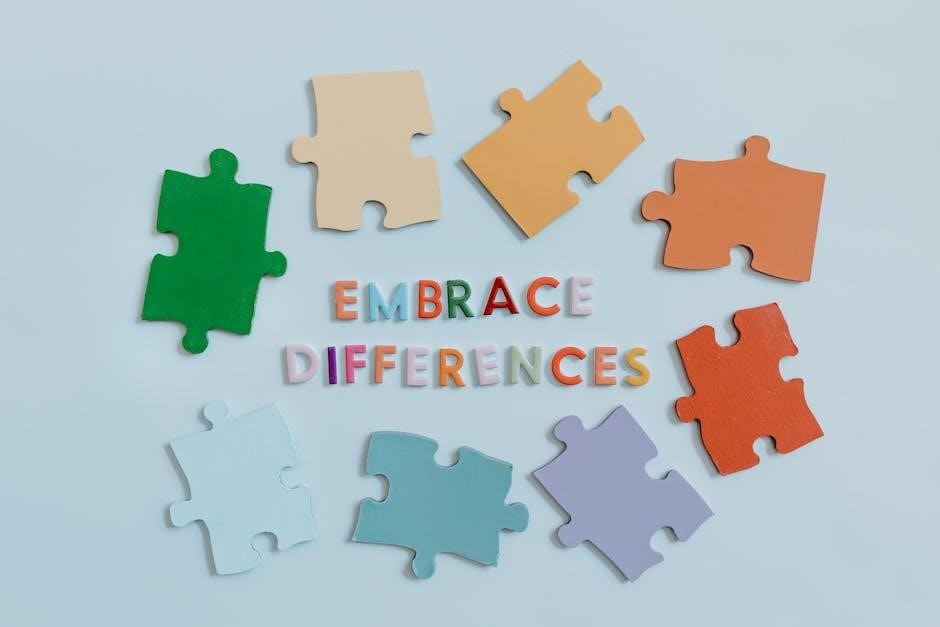Sign language is a visual and tactile method of communication, breaking barriers for autistic individuals. It empowers expression, reduces frustration, and fosters connection. With adaptable techniques, it supports diverse needs, offering a bridge to understanding and engagement, supported by guides and studies.
Understanding the Importance of Communication for Autistic Individuals
Effective communication is vital for autistic individuals, as it enables self-expression, builds relationships, and reduces frustration. Many autistic children face challenges with verbal language, leading to isolation or behavioral difficulties. Alternative communication methods, such as sign language, provide a meaningful way to bridge this gap. Research highlights that visual and tactile approaches, like manual signs, can be particularly effective for individuals with autism spectrum disorder (ASD). These methods align with how many autistic learners process information, offering a clear and structured way to convey thoughts and emotions. By addressing communication barriers, sign language helps foster independence, confidence, and social interaction, making it a valuable tool in supporting autistic individuals.

Overview of Sign Language as a Tool for Communication
Sign language is a widely recognized method of communication that uses manual signs, facial expressions, and body language to convey messages. It serves as a powerful tool for individuals with autism, particularly those who struggle with verbal communication. Unlike spoken language, sign language is visual and tactile, making it easier for many autistic learners to process and understand. It can be tailored to individual needs, incorporating graphic symbols or voice output devices for enhanced clarity. Research indicates that sign language acquisition can significantly improve communication outcomes for autistic children, offering a structured and accessible means of expression. Its adaptability and effectiveness make it a cornerstone in supporting individuals with autism spectrum disorder (ASD), providing a clear pathway for meaningful interaction and understanding.

Benefits of Sign Language for Individuals with Autism
Sign language empowers autistic individuals by enhancing communication, fostering confidence, and reducing sensory overload. It promotes emotional expression and social connections, improving overall well-being.
Improved Communication Skills
Sign language significantly enhances communication for autistic individuals by providing a clear, visual, and tactile method of expression. It breaks down barriers, enabling individuals to convey thoughts and needs effectively. Many autistic children benefit from the structured and predictable nature of sign language, which reduces frustration and emotional distress. Studies show that using sign language can lead to improved verbal and non-verbal communication skills over time. It also offers an alternative for those with limited or no speech abilities, ensuring their voices are heard. By combining signs with visual aids or electronic devices, communication becomes more accessible and engaging. This approach fosters confidence and encourages active participation in daily interactions, proving to be a powerful tool for connection and understanding.
Enhanced Emotional Regulation and Expression
Sign language provides autistic individuals with a structured and predictable method for expressing emotions, reducing frustration and emotional distress. By offering a clear visual and tactile means of communication, it helps individuals convey feelings effectively, even when verbal communication is challenging. This clarity fosters emotional regulation, as it eliminates misunderstandings and empowers self-expression. Many autistic individuals experience reduced anxiety and meltdowns when using sign language, as it provides a reliable outlet for their emotions. Additionally, the physical act of signing can be calming and grounding, aiding in emotional stability. This tool not only enhances emotional expression but also strengthens overall well-being, allowing individuals to navigate social and emotional challenges with greater confidence and ease.
Increased Participation in Social Interactions
Sign language significantly enhances autistic individuals’ ability to engage in social interactions by providing a clear and accessible communication method. It bridges gaps in verbal communication, enabling meaningful exchanges and fostering connections; Many autistic individuals report feeling more confident in social settings when using sign language, as it reduces barriers to understanding and being understood. This confidence often leads to increased participation in group activities, shared conversations, and community events. By facilitating expression and comprehension, sign language helps autistic individuals build friendships and collaborate with peers. It also encourages active listening and reciprocity, which are essential for healthy social dynamics. As a result, sign language not only improves communication but also strengthens social bonds and promotes a sense of belonging in various social environments.

The Role of Sign Language in Autism Spectrum Disorder (ASD)
Sign language plays a crucial role in ASD by providing a visual and tactile communication method, bridging gaps for individuals with verbal challenges; It supports expression, reduces barriers, and fosters connections, backed by guides and research highlighting its effectiveness in enhancing communication and social engagement for autistic individuals.
Manual Signs and Their Effectiveness
Manual signs, a core component of sign language, are highly effective for individuals with autism, offering a clear, visual, and tactile means of communication. Research, such as the 2016 study in Language, Speech, and Hearing Services in Schools, highlights their success in aiding expression and understanding. These signs reduce frustration by providing an alternative to verbal communication, especially for those with limited speech abilities. They also support speech development and social interactions, as they can be paired with verbal cues. Manual signs are adaptable, allowing customization to meet individual needs, and are often used alongside other AAC methods for enhanced effectiveness. Their visual nature aligns well with the learning preferences of many autistic individuals, making them a valuable tool in fostering communication and connection.
Graphic Symbols and Voice Output Communication Aids
Graphic symbols and voice output communication aids (VOCA) are powerful tools that complement manual signs, offering additional support for autistic individuals. These systems use visual representations, such as pictures or symbols, to convey messages, which can be particularly effective for those with strong visual learning preferences. VOCAs, which produce speech when symbols are selected, help bridge the gap between visual and auditory communication. Research, including a 2016 study in Language, Speech, and Hearing Services in Schools, highlights their effectiveness in fostering communication and social interactions. These tools are highly adaptable, allowing customization to suit individual needs, and can be used alongside manual signs for a comprehensive communication approach. They are especially useful for those with limited or no speech, providing a reliable means of expression and reducing communication barriers.
Case Studies on Sign Language Acquisition in Autistic Children
Case studies highlight the successful acquisition of sign language by autistic children, demonstrating its impact on communication and development. A 2014 study by Aaron Shield explored how deaf children with autism spectrum disorder (ASD) acquire sign language, emphasizing its role in fostering linguistic and social skills. Another study from 2023 focused on the effectiveness of sign language in improving communication among autistic children, showing significant reductions in frustration and enhances expressive abilities. These real-life examples illustrate how tailored sign language programs, supported by resources like the Autism-English-download.pdf guide, can address individual needs. Such research underscores the importance of early intervention and personalized approaches in helping autistic children thrive through sign language.

How to Get Started with Sign Language for Autism
Parents and caregivers can begin by accessing downloadable guides like the Autism-English-download.pdf for foundational knowledge. Utilizing online platforms and visual aids enhances learning and application, ensuring effective communication strategies for autistic individuals.
Resources for Learning Sign Language
Various resources are available to help parents and caregivers learn sign language for autism. The Autism-English-download.pdf guide provides foundational knowledge, while platforms like Sign Language And Autism.pdf offer comprehensive learning materials; Online communities and forums serve as collaborative spaces for sharing techniques and experiences. Books, such as those analyzing verbal behavior and ASL teaching methods, are invaluable tools. Additionally, studies and publications from experts like Dr. Mary Lynch Barbera offer evidence-based strategies. These resources cater to diverse learning needs, ensuring accessible and effective communication support for autistic individuals. By leveraging these materials, caregivers can confidently begin their sign language journey, fostering meaningful connections and empowerment for those with autism.

Downloadable PDF Guides for Parents and Caregivers
Downloadable PDF guides are essential tools for parents and caregivers seeking to learn sign language for autism. The Autism-English-download.pdf guide, accessible via www.ASDinfoWales.co.uk, offers comprehensive insights and practical strategies. These guides often include step-by-step instructions, visual aids, and real-life scenarios to facilitate learning. They emphasize the importance of manual signs, visual symbols, and tactile approaches, catering to diverse communication needs. Many PDFs are designed to be user-friendly, ensuring accessibility for individuals with varying skill levels. By providing evidence-based methods and adaptable techniques, these resources empower caregivers to support autistic individuals effectively. They serve as invaluable companions for fostering meaningful communication and connection, making them a cornerstone of sign language learning for autism support.
Online Platforms for Sign Language Learning

Online platforms have revolutionized sign language learning, offering accessible and interactive tools for parents and caregivers. Websites like Sign Language Pro and ASL Rochelle provide structured lessons, video tutorials, and progress tracking. These platforms cater to diverse learning styles, ensuring a comprehensive understanding of sign language. Many offer specialized resources for autism, focusing on clear visual aids and tactile approaches. For instance, Speechling and Handspeak include interactive modules tailored for children with ASD, emphasizing manual signs and emotional expression. These platforms foster a collaborative learning environment, often featuring forums for sharing experiences. By leveraging technology, they make sign language education convenient and engaging, empowering caregivers to support autistic individuals effectively.

Sign Language and Augmentative and Alternative Communication (AAC)
Sign language integrates seamlessly with AAC, enhancing communication for autistic individuals. It combines manual signs with visual aids like picture boards and electronic devices, supporting diverse expressive needs effectively.
Combining Sign Language with Visual Aids
Combining sign language with visual aids creates a powerful communication system for autistic individuals. Visual aids like picture boards or electronic devices enhance understanding, especially for those with limited verbal skills. This approach supports the integration of manual signs, making communication more accessible and engaging. For example, using graphic symbols alongside signs can help individuals connect gestures with meanings, fostering clearer expression. Resources such as downloadable PDF guides provide structured lesson plans and visual tools, making it easier for parents and caregivers to implement this method; By merging tactile, visual, and kinesthetic learning, this strategy addresses diverse learning styles, reducing communication barriers and promoting independence. This combination is particularly effective in daily routines, enabling individuals to convey needs and emotions more effectively.
Electronic Communication Devices and Their Role
Electronic communication devices play a crucial role in supporting autistic individuals, offering an alternative or supplement to sign language. These devices, such as tablets with communication apps or dedicated AAC devices, provide customizable visual and auditory supports. They enable users to convey messages through pre-programmed symbols, words, or phrases, which can be paired with sign language for enhanced understanding. For non-verbal individuals, these tools are especially vital, allowing them to express needs, wants, and emotions effectively. Many devices offer real-time feedback, fostering learning and independence. Resources like downloadable PDF guides help caregivers and therapists implement these technologies, ensuring they align with individual needs. By integrating electronic devices into daily routines, communication becomes more accessible and empowering, bridging gaps in traditional methods.

Research on Sign Language and Autism
Research highlights the effectiveness of sign language in improving communication for autistic individuals, supporting speech development, and providing long-term benefits when implemented early.
Studies on the Effectiveness of Sign Language in Communication
Research consistently demonstrates the positive impact of sign language on communication for autistic individuals. Studies, such as those published in 2016 and 2014, highlight its effectiveness in fostering verbal and non-verbal expression. These findings show that sign language reduces communication barriers, enhances emotional regulation, and promotes social interactions. For instance, manual signs have been proven to aid in speech development, while graphic symbols and voice output devices offer additional support. Early intervention with sign language has been linked to long-term benefits, including improved communication skills and increased confidence. These studies underscore the importance of tailored approaches, emphasizing that sign language can be adapted to meet the unique needs of each individual, making it a powerful tool in supporting autistic individuals.
The Impact of Sign Language on Speech Development
Sign language has been shown to positively influence speech development in autistic individuals. By providing a visual and tactile foundation, it reduces communication frustration and encourages verbal expression. Research indicates that manual signs, when used alongside spoken language, can enhance phonological awareness and articulation. For example, a 2016 study highlighted that children who learned manual signs demonstrated improved speech clarity and vocabulary expansion. Additionally, graphic symbols and voice output devices complement sign language, offering multi-modal learning opportunities. These tools not only support speech development but also foster a stronger connection between visual cues and auditory processing. Early introduction of sign language can stimulate brain plasticity, helping individuals integrate signs with sounds and words, ultimately promoting more effective communication skills over time.
Long-Term Benefits of Early Sign Language Intervention
Early sign language intervention offers significant long-term benefits for autistic individuals. It fosters improved communication skills, emotional expression, and social interactions. By reducing frustration and enhancing confidence, sign language empowers individuals to connect more effectively with their environment. Research indicates that early exposure to manual signs and visual aids can lead to better speech development and a smoother integration of signs with spoken language. Over time, this can result in greater independence and a higher quality of life. Studies highlight that children who begin sign language early tend to exhibit more advanced communication abilities later in life. This proactive approach not only supports immediate needs but also lays a strong foundation for long-term personal growth and social engagement.

Cultural and Global Perspectives on Sign Language for Autism
Sign language practices for autism vary globally, reflecting cultural adaptability. Accessibility of resources differs, yet shared goals of empowerment and inclusion unite worldwide efforts in supporting autistic individuals.
Sign Language Practices in Different Countries
Sign language practices for autism vary significantly across cultures, with countries adapting techniques to their unique linguistic and social contexts. In Wales, for instance, resources like “Autism-English-download.pdf” provide tailored guidance, while in the U.S., American Sign Language (ASL) is commonly integrated. Studies show that manual signs, graphic symbols, and voice output aids are widely used globally. For example, the U.S. emphasizes ASL for communication, whereas other countries may blend local sign languages with visual aids. These practices highlight the adaptability of sign language to meet diverse needs, ensuring accessibility and fostering inclusion for autistic individuals worldwide. Such global variations underscore the importance of cultural sensitivity in implementing effective communication strategies for autism.
Accessibility of Sign Language Resources Worldwide
Sign language resources for autism are increasingly accessible globally, thanks to digital platforms and downloadable materials. Websites like www.ASDinfoWales.co.uk offer free guides, such as “Autism-English-download.pdf,” providing valuable tools for parents and caregivers. Online platforms enable users to access PDF files, books, and studies on sign language and autism, ensuring widespread availability. Additionally, global initiatives promote the use of visual aids, electronic devices, and manual signs, catering to diverse learning needs. Research from countries like the U.S. and Wales highlights the effectiveness of these resources in improving communication for autistic individuals. The growing availability of these materials in multiple formats ensures that families worldwide can benefit from sign language-based strategies, fostering inclusivity and support for autism care.
Sign language empowers autistic individuals, fostering communication and emotional expression. It bridges gaps, offering tailored strategies and global resources, proving vital for inclusive support and understanding.
Summarizing the Importance of Sign Language for Autistic Individuals
Sign language is a powerful tool for autistic individuals, enabling effective communication and emotional expression. It bridges non-verbal communication barriers, fostering social interactions and reducing frustration. By providing a visual and tactile method, sign language supports diverse learning styles, helping individuals convey needs and feelings. Its adaptability makes it accessible for those with varying abilities, promoting inclusivity and understanding. Guides and resources, such as downloadable PDFs, offer practical strategies for parents and caregivers. Research highlights its effectiveness in improving speech development and long-term communication skills. Ultimately, sign language empowers autistic individuals, enhancing their quality of life and fostering meaningful connections with others.
Future Directions for Sign Language in Autism Support
Future directions for sign language in autism support emphasize collaboration between speech therapists, educators, and caregivers to create tailored communication strategies. Integrating technology, such as apps and electronic devices, can enhance accessibility and engagement. Expanding cultural adaptations of sign language resources ensures global inclusivity. Research into long-term benefits and early intervention outcomes will guide policy and practice improvements. Increasing awareness and training programs for parents and professionals are critical. Combining sign language with visual aids and AAC tools offers a holistic approach. Advocating for standardized resources and accessible platforms will empower autistic individuals worldwide. By addressing these areas, sign language can continue to play a transformative role in autism support.


